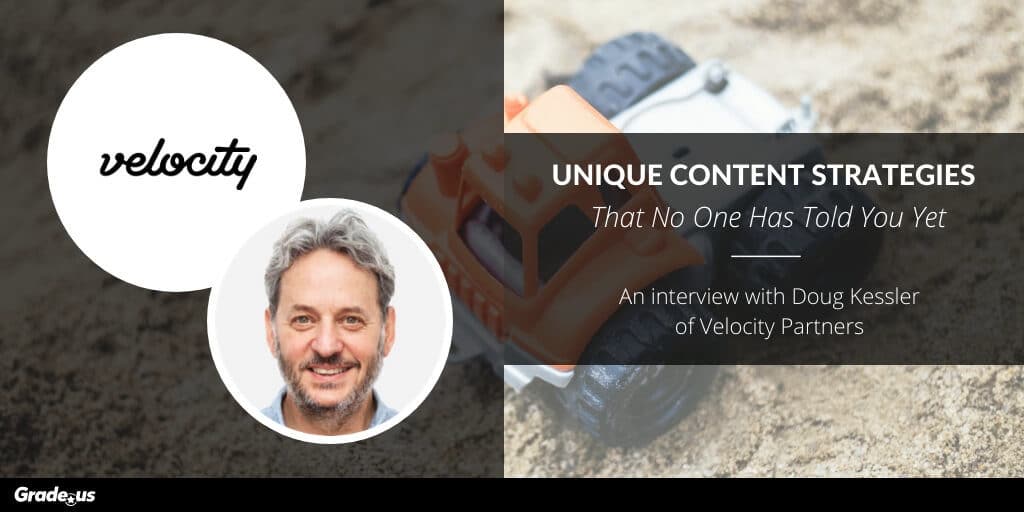Sometimes even great advice about content marketing rings a little stale.
Spend 45 hours and sacrifice a chicken to create the perfect headline.
Write articles that are between 2500 and 3000 words, and if you happen to be writing about a subject you think only needs 250 to 300 words, you’re just not digging deep enough.
Figure out what everyone else is doing, and do that, only better.
Meanwhile, Doug Kessler might just encourage and challenge you to create a piece of content that never once uses the letter “a,” just to see what happens.
This fresh approach brings real results. Doug is the Creative Director and Co-Founder of Velocity Partners, an agency which just won the 2019 B2B Agency of the Year at the Drum Awards, an event he describes as “a pleasant surprise.” Meanwhile Velocity’s clients, companies like Sprint and Salesforce, probably weren’t at all surprised. Doug gets results.
If you’re ready for some fresh yet effective advice, this Q&A is a great place to find it.
The nitty gritty of B2B content marketing
Raney: Because you’re a content marketing expert, and a strong voice in encouraging business to do content better, I’d like to kick us off by asking what agencies, consultancies, and brands are getting wrong about B2B content marketing.
Doug: I think brands are getting a lot right, and are getting better and better all the time. But things are getting lost as content marketing gets industrialized and dissolved into the mainstream of marketing.
It becomes bedded down like any other process, like PR was at one time (and probably still is), and that has a deadening effect. Once you get a grooved process for anything there’s a danger of gravity setting in.
The exciting time in content marketing was when we were all discovering, learning, and experimenting. We need to do some of that, learn from our mistakes, and then scale things up to do them properly.
Another mistake may be confining content to demand generation or lead generation. It can be so much more. Some of the great B2B content is essentially a brand-level play, and not enough B2B brands are using it for that.
Raney: Can you give me an example of what the difference was between content in this period of experimentation and excitement, and what it looks like now?
Doug: In the early days of content marketing, we were all making discoveries and were excited about storming the barricades of traditional marketing. We were all engaging in positive conversations in the very beginning.
We were all learning at the same time, across the industry. Agencies, clients, everybody.
We were saying, “Oooh, this can be content. That can be content. Hey, video. Hey, infographics. Look how they can work together!”
The spirit was just really fun, but it also attracted a certain kind of marketer who had the confidence to go for it. I think as gravity sets in, and it becomes mainstream, it attracts a more process-oriented person.
Now, I’m not anti-process at all. I’ve become a big, big fan of getting it right, but I do think we’ve lost the sense of being in a playground, being in a sandbox, exploring, figuring things out, daring to fail in public, and having fun doing it.
On working with clients on content
Raney: When you get a new client, what’s your approach to helping them develop a more exciting, interesting content strategy that really stands out?
Doug: It feels cliche now to talk about empathy, but everything good has to start with it. Even though everyone knows that, people skip through the persona stage. People skip through the listening stage and get a little bit complacent about who their audience is, and what they care about.
If one can really get inside the customer, the prospect, the target audience, different things open up. There is no such thing as too much insider empathy about your target audience. The more you can accrue, the more new on-target ideas come out. The better your chances of producing content that is relevant and timely, that resonates with these people.
Start there. We work for our clients. Our clients pay us. But in a sense, we really work for their customers. We have to be an advocate for that prospect and that audience. We have to argue with our clients when we think a story isn’t as good, believable, clear, or fresh as they think it is.
It may be cliche, but it’s also under-practiced.
On the roll of keyword research in content development
Raney: Your focus is very much on content, not on SEO. Do you use keyword research when you do content?
Doug: We definitely do.
In the beginning, yeah, we kind of dissed SEO. I think what we were doing was dissing lazy SEO and bad SEO.
Back then it was all about gaming the algorithm and outsmarting Google to surface content, even when it didn’t deserve to be surfaced. We decided to trust Google’s billions to figure out the best ways to discover and surface real relevance.
So we thought, let’s just serve the human audience and let search take care of itself.
It was the right call, but we oversimplified and went too far the other way.
Clearly, keyword research tells you the words and language your audience is using when they think about certain issues. You’re crazy not to use that and put it into the mix.
We’ve come back to the proper middle ground. Not rejecting SEO and SEM, and saying, “Look, absolutely, we need to know these things, we need to look for opportunities where content can own a term or do really well on a term and earn the right traffic.”
We also need to know there’s a ton of content we do that simply won’t be search powered. Let’s say we’re inventing a category nobody’s looking for yet. We have to know that, and be okay with it, and say, “This is not a search play. This is a different kind of play.”
Both are important. We respect great SEO quite a bit, and are doing more and more of it, ironically.
On the philosophy behind content experimentation
Raney: You also suggest reserving 10% of your marketing budget for content experiments. What kinds of experiments have you been running lately, and what were the results?
Doug: Experiments are a huge thing.
For our own marketing at Velocity they can be as small as, “How does a .gif work in there, or which different CTAs work.” That’s on-going stuff, and it’s the experimental mindset of the optimizer.
But then there are the bigger plays and punts, like trying new formats.
We invented this thing called a Velocity String, which is a Slideshare on steroids. We loved SlideShare, but it had some big limitations. And so we thought, well, what would we do if it was an on-page Slideshare? We had no idea if it would work. It did. It became a really big format for us.
Another one we learned a lot from are these “in a day” experiments our team has been doing. The idea is, “what can we do in a day?” We did a video in a day. We did a case study in a day.
The 10% idea is that you’re going to ring fence your experimentation budget so it doesn’t get raided by the comfort zone stuff everyone has to do. Make sure people buy in to why you’d ring fence it, and spend it.
Raney: Have any of these wilder and whackier experiments gotten you really awesome results?
Doug: Definitely.
Early in our life we experimented with something we called a rant. I’m not saying we invented the rant, but in B2B we thought: “Hey, there’s not enough emotion and passion here.” So we created impassioned rants at very high altitude, and with a lot of momentum.
For example, we tried something called: Crap: Why Content Marketing is Killing Content Marketing.
It was a Slideshare way back when that was a good thing. It was about using Slideshare as a medium. Back then it was really just a dumping ground for decks you presented somewhere else.
I’ve had failures too. We tried what we thought was a funny film called Stepping Into the Future. It overdubbed an old black and white Public Service announcement. It flopped badly, and that was in public! You have to be willing to walk the walk of shame if you’re going to do anything different.
On developing the tone of your content
Raney: Another thing you’ve talked about is developing a business tone of voice and stand. When you’re helping your clients develop these tools, what are your initial steps with them?
Doug: We listen really hard to who they are.
A lot of people impose voice from the outside, and lay it on like a veneer. We feel like voice really does need to come out of the DNA of the company and out of the actual brand, not just the brand they wanna be.
So we listen to the people in the company who are having the most fun and are the most passionate. They’re often the founders, or the product people, or the engineers who are doing great things they love. We try to bottle that voice.
Then we can say, “Look, here’s the voice. It’s right here in the notes, in the recordings of the meetings. You already have your voice, it just has to reach the audience.”
Raney: If a company has a large marketing team that works on content, how do you guide them into creating collateral that reflects that tone of voice? I know you can do things like creating a brand or style guide, but the question that arises is: words have different connotations. What I perceive or take as being “dry humor” may not be what you perceive as “dry humor.” So how do you overcome that communication problem?
Doug: Good question, and the bigger the company, the bigger the challenge.
Instead of focusing on being the brand police, lots of “don’t do this, don’t do that,” these guides need to function more like cheerleading coaches. Go for it. Go ahead and try this.
You’re right that it can be dangerous. I think that’s where good editors come in.
Part of it is valuing talent. It’s not expecting great work from so-so talent. It is recognizing there is such a thing as talent in this, and then working really, really hard to get that talent. You can’t just impose a set of guidelines onto someone who may not be that great a writer and expect to get something good out of the other side.
To be brutal, we see mediocre talent in agencies and in clients. They settle for it, and then that talent is on the team. They like the mediocre talent as people, so it’s like, well, this is what we’ve got, this is the best we’re going to do.
The challenge is real, and tough, but if you don’t have the bar, the goal, and the drive to do it your chances of doing it go down to zero. If you’re going for it, and trying, your chances go up and up.
On turning the customer into the hero of your client
Raney: Some of the content I know performs really well would be the sorts of stories that turn the customers into heroes. When you work with a new brand, how do you get people to transition their mindset a little bit towards doing that sort of thing? How do you get stakeholder buy-in to do it instead of endlessly talking about “this is what we’re doing” instead of “this is what our customer is out there doing, maybe using our thing?”
Doug: We don’t find that much resistance to customer as hero. Mostly when we bring that up people are like, “Yeah, let’s do it!” What’s hard is making it distinctive and making it stand out because it tends to devolve into case studies very quickly.
Case studies have their place, and can be done wonderfully, but are often very conventional. They signal “case study” so people don’t get that engaged with them. You know the signals. “The challenge. The solution.”
There are so many other ways to tap into the voice of the customer which are more exciting than case studies.
People assume, “Well, if they’re the customer, they must be talking about us.” No! They’re experts in their field. They’re people who you believe are best practitioners. Ask them about other stuff, not just about you. Put them on a pedestal for their views on the whole field, on the key issues, and the timely critical challenges.
There’s also the extra layer of approval problems. Their corporate brand police, as well as the client’s. So there are those challenges too. For me, it’s less about resistance and more about logistics.
The solution is to take away the endorsement part of it. “No, don’t endorse us. Come talk about what you’re great at.” There’s no endorsement at all. It’s implied, but it’s not there. It oughta fly through the approval process as well.
On 2020 content marketing predictions
Raney: Finally, since it’s that time of year…what do you think content marketers should be focusing on as we head into 2020?
Doug: One thing we’re evangelizing a lot is the “galvanizing story.” We feel like many B2B brands are missing a clear, structured narrative.
Cynically you could say it’s “why you do what you do,” but it’s a little more than that. It’s about evangelizing the change in the world that makes your company important. It’s how your company can help seize the opportunities and avoid the threats a changing world brings.
When companies are missing this story they do a whole bunch of activities, but there’s still this black hole in the middle of the brand. They become a zombie brand, instead of a super-meaningful brand.
I’d hope every B2B marketer in 2020 is thinking about their story so it can unite all those other activities in a way that really multiplies the client’s value.
You can find out more about Doug on the Velocity Partners website, or by following him at @dougkessler.









